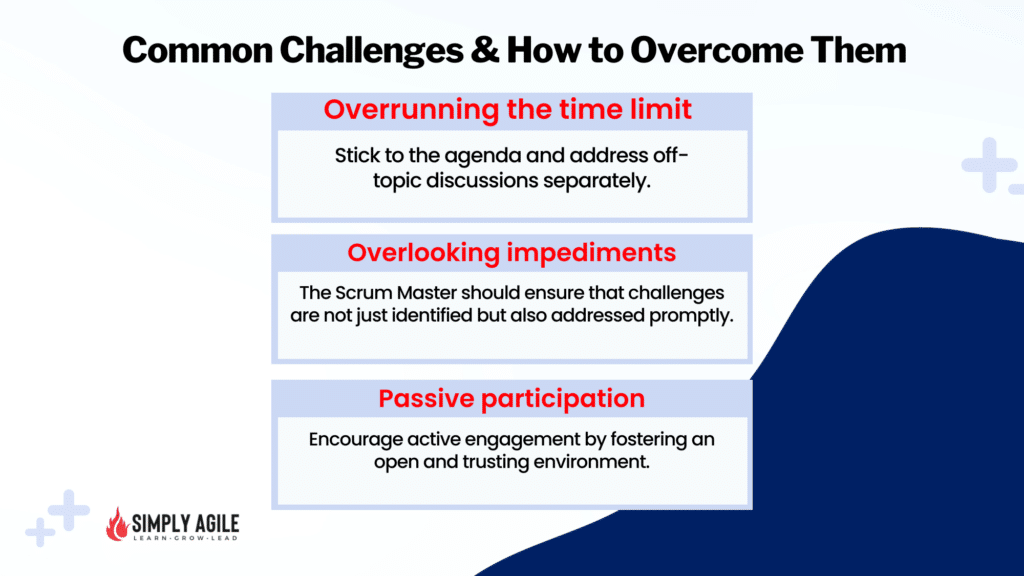How the 5 Scrum Events Fuel Agile Triumph: Secrets Unveiled


Table of Contents
Scrum events are more than just meetings; they’re the heartbeat of Agile Initiatives, setting the rhythm for success.
Have you ever wondered why some Agile teams consistently deliver results while others struggle? The secret often lies in how effectively they leverage the power of Scrum events. From planning sprints to retrospectives, each event plays a crucial role in shaping the project’s direction and outcome.
Don’t mistake Scrum events for mere calendar fillers. They’re the rhythm section of your Agile band. Sprints align, standups clarify, and retrospectives evolve. Get the timing right, and the whole crew moves in harmony.
Many teams trip over the basics, missing the beat entirely. Why? They lack the how-to for maximizing these crucial touchpoints.
We’re pulling back the curtain. This guide is your toolkit for transforming Scrum events into your team’s powerhouse.
How Many Scrum Events Are There?
Navigating the world of Agile can be akin to mastering a dance, with each step having its own rhythm and purpose.
In Scrum, these steps are embodied by five core events, each designed to ensure seamless collaboration, clear communication, and a laser-focused approach to achieving project goals.
Let’s delve into these events to understand their significance and value to the Agile table.
For a fun history lesson on the origins of Scrum, take a look at A Brief History of Scrum.
1. Sprint Planning: Laying the Foundation for Success
At the onset of every sprint, teams gather for arguably one of the most pivotal Scrum events: Sprint Planning. This event sets the stage for the entire sprint, ensuring everyone is aligned on the goals and understands the path forward.
Objective and Goals of the Sprint Planning Event:
The primary objective of Sprint Planning is to determine what work will be tackled during the upcoming sprint. The team collaborates to select items from the product backlog, breaks them down into manageable tasks, and commits to a set of deliverables by the end of the sprint.
Key Participants and Their Roles:
Product Owner: Presents the product backlog items, clarifies doubts, and sets the priority based on business value.
Developers: Discuss the feasibility of each item, estimate the effort required, and commit to the work they believe they can complete.
Scrum Master: Facilitates the meeting, ensures the team stays on track, and addresses any impediments or concerns.
The Outcome:
By the end of Sprint Planning, the team has a clear and actionable sprint backlog, a shared understanding of the sprint’s goals, and a collective commitment to achieving those goals. This clarity and alignment are crucial for maintaining momentum and ensuring a successful sprint outcome.
2. Daily Scrum: Keeping the Pulse of Progress
The Daily Scrum is a brief yet powerful touchpoint amid the sprint’s hustle and bustle. Lasting no more than 15 minutes, this daily ritual ensures that the team remains synchronized, obstacles are swiftly identified, and momentum is maintained.
The Importance of Daily Communication Among Team Members:
The Daily Scrum is not just a status update; it’s a platform for transparency, collaboration, and accountability. Team members foster a culture of mutual support and collective problem-solving by sharing their progress and challenges.
Typical Structure and Duration:
Time-boxed to 15 minutes: To ensure efficiency and focus.
Same time, same place: Consistency helps establish a routine.
Three key questions: Each team member answers:
What did I accomplish yesterday?
What will I work on today?
Are there any impediments or obstacles in my way?
The Role of the Scrum Master:
While the Daily Scrum is a team event, the Scrum Master is crucial in facilitating it. They ensure that the meeting stays on track, that every voice is heard, and that identified impediments are addressed on time.
The Outcome
The Daily Scrum provides a clear snapshot of the sprint’s progress and the team’s current trajectory. It ensures that everyone is aligned, fosters a sense of collective ownership, and catalyzes proactive problem-solving. (Learn more about How Scrum Masters Can Support Problem-solving Workshops)
3. Sprint Review: Showcasing Achievements and Gathering Feedback
As the sprint draws to a close, the Sprint Review offers a platform for the team to present their accomplishments, gather feedback, and refine the product vision. It’s a moment of reflection, celebration, and forward-thinking.
The Purpose of Reviewing Work Done During the Sprint:
The Sprint Review is not merely a demonstration of completed work. It’s an interactive session where stakeholders provide feedback, ensuring the product aligns with user needs and business objectives.
Stakeholder Involvement and Feedback:
Product Owner: Presents the initial goals of the sprint and the items from the selected product backlog.
Developers: Demonstrates the completed work, discusses challenges faced and highlights any items that couldn’t be finished.
Stakeholders: Offer feedback on the presented work, which can lead to new insights or adjustments to the product backlog.
The Role of the Scrum Master:
The Scrum Master ensures that the Sprint Review stays focused and productive. They facilitate the session, manage time, and ensure constructive feedback aligns with Scrum values.
The Outcome:
The Sprint Review culminates in a refined product backlog, ensuring that the team’s future efforts are aligned with stakeholder feedback and the evolving product vision. It fosters collaboration between the team and stakeholders, ensuring everyone is on the same page regarding the product’s direction.
Looking For An Agile Community?
Join hundreds of other Agilist’s as we build a network of motivated and passionate tech professionals. Join for free and attend free events, groups, and learn from Agile leadership coaches.
4. Sprint Retrospective: Reflecting, Learning, and Growing
After the sprint’s work is showcased and feedback is gathered, the team joins again for the Sprint Retrospective. This event is a dedicated space for introspection, aiming to celebrate successes, identify areas of improvement, and chart a path forward for the next sprint.
Reflecting on the Sprint's Successes and Areas for Improvement:
The Sprint Retrospective is not about finger-pointing or blame. It’s a constructive session where the team acknowledges what went well and discusses what could be done better.
Techniques for Conducting an Effective Retrospective:
Start, Stop, Continue: What should the team start doing? What should they stop doing? What should they continue doing?
4Ls – Liked, Learned, Lacked, Longed For: A reflection on the team’s feelings and learnings during the sprint.
Sailboat: Identifying winds (things that helped), anchors (things that hindered), and risks (potential future challenges).
Action Items and Continuous Improvement:
Every retrospective should result in actionable takeaways. These action items are commitments from the team to improve specific aspects of their process or dynamics.
The Role of the Scrum Master:
The Scrum Master facilitates the retrospective, ensuring a safe and open environment where team members feel comfortable sharing their thoughts. They also help prioritize action items and ensure they are addressed in the subsequent sprint.
The Outcome:
The Sprint Retrospective fosters a culture of continuous improvement. By regularly reflecting on their performance, teams can adapt, evolve, and consistently enhance their efficiency and effectiveness.
5. Sprint: The Heartbeat of Scrum
In Scrum, the Sprint is where ideas transform into value. It’s a time-boxed period during which specific work is completed and made ready for review. More than just a phase, the Sprint is the fundamental unit of the Scrum framework, driving progress and innovation.
Definition and Duration of a Sprint:
A Sprint is a fixed-length event, typically lasting between one and four weeks, during which the team works to turn selected product backlog items into a potentially shippable product increment.
Deliverables and Expected Outcomes:
Potentially Shippable Product Increment: By the end of the Sprint, the team should have a piece of work that is of high quality, meets the Definition of Done, and could be delivered to the customer.
Updated Product Backlog: The team might discover new tasks or requirements as the Sprint progresses, leading to an updated product backlog.
Insights for Future Sprints: Each Sprint offers lessons that can be applied to future iterations, ensuring continuous improvement.
Balancing Flexibility with Commitment:
While agility and adaptability are at the core of Scrum, once the team commits to a set of backlog items in Sprint Planning, they aim to deliver on that commitment. This balance ensures that while the team remains responsive to change, they also focus on delivering value.
The Role of the Scrum Master:
During the Sprint, the Scrum Master plays a pivotal role in ensuring the team stays on track. They remove impediments, shield the team from external interruptions, and ensure they have all the necessary resources to succeed.
The Outcome:
The culmination of a Sprint is a tangible representation of the team’s effort, creativity, and commitment. It’s a testament to the power of collaboration and the Scrum framework’s ability to drive results in a structured yet flexible manner.
The Synergy of Scrum Events: A Harmonious Dance of Collaboration
Scrum is not just a collection of individual events; it’s a finely tuned system where each event feeds into the next, creating a seamless flow of information, collaboration, and progress. Each event has its purpose and value when viewed in isolation, but when they come together, they create a synergy.
How Each Event Complements the Others:
Sprint: The overarching container within which all these events occur, driving the team towards delivering value incrementally and iteratively.
Sprint Planning: This is where the vision for the upcoming Sprint is set. The team aligns on goals and maps out the journey ahead.
Daily Scrum: As the team embarks on the journey, it ensures they remain on course, addressing challenges and celebrating small victories daily.
Sprint Review: Upon reaching the end of the Sprint, the team showcases their achievements, gathering feedback to ensure the product is on the right track.
Sprint Retrospective: Before embarking on the next journey, the team reflects on the past Sprint, ensuring that lessons learned are carried forwar
When it Works It Works
When Scrum events are executed in harmony, they create a rhythm that teams can dance to. This rhythm ensures that teams are not just going through the motions but are genuinely collaborating, innovating, and delivering value with each passing Sprint.

Common Misconceptions About Scrum Events
Scrum often becomes a subject of misunderstandings with its structured approach and specific events. Let’s debunk some common misconceptions:
Daily Scrum is Just a Status Update
Reality: Beyond updating work progression, the Daily Scrum fosters collaboration, identifies impediments, and ensures alignment.
Sprint Planning is Only About Task Allocation
Reality: Sprint Planning is a collaborative effort where the team aligns on goals, discusses feasibility, and commits to deliverables.
Sprint Reviews are Just Demos
Reality: While showcasing work is a part, Sprint Reviews are interactive sessions to gather feedback and ensure the product aligns with stakeholder needs.
Retrospectives are Blame Games
Reality: Sprint Retrospectives are constructive sessions focused on continuous improvement, not pointing fingers.
Sprints are Rigid and Don’t Allow Changes
Reality: Scrum values adaptability, while sprints aim to complete committed backlog items. Emergent requirements can be addressed in subsequent sprints.
Understanding the true essence of events is crucial for harnessing their full potential and avoiding pitfalls. By dispelling these myths, teams can approach Scrum with clarity and confidence.
Conclusion
Scrum events are more than just structured meetings; they’re the pillars that uphold the Scrum framework, guiding teams toward innovation, collaboration, and success.
By understanding their essence and dispelling common misconceptions, teams can unlock productivity and drive projects to fruition.
But remember, the journey of mastering Scrum doesn’t end here. Continuous learning, sharing experiences, and networking with like-minded professionals can elevate your Agile journey.
Ready to take your Scrum expertise to the next level?
Join the Simply Agile Community today! Dive into a world of insights, engage in enriching discussions, and be a part of a community shaping Agile’s future. Together, let’s make Agile not just a methodology but a movement.
Read our latest post: Can the scrum master and product owner be the same person?
Written by
Nelson Ingle | Founder of Simply Agile
Coach Nelson has 10+ years of experience leading software development teams. As a lifelong learner, he’s passionate about helping community members discover and pursue their ikigai every day.
Scrum events, or ceremonies, are essential gatherings within the Scrum framework that facilitate collaboration and communication among team members. They include Sprint Planning, Daily Scrum, Sprint Review, and Sprint Retrospective.
The Daily Scrum event aims to enhance the chances of delivering a “Done” and usable product increment that aligns with the Sprint Goal. During this daily meeting, team members monitor their progress and plan their tasks for the next 24 hours.
A Sprint is typically a time-boxed iteration in Scrum, lasting 2 to 4 weeks. It represents the timeframe during which the developers work to achieve the goals set for that Sprint.
The Sprint Review event is held at the end of a Sprint. During this event, the developers showcase the work completed during the Sprint to stakeholders, such as product owners and users. It serves as an opportunity to gather feedback and adjust the product backlog.
The Sprint Retrospective event provides a dedicated space for the Scrum team to reflect on the previous Sprint. Team members discuss what went well and what could be improved and identify actionable items for enhancing their processes in the next Sprint.
While Sprint Planning, Daily Scrum, Sprint Review, and Sprint Retrospective are the core Scrum events, Sprint itself is the overarching time frame for development activities. These five events together make up the Scrum framework.









Responses